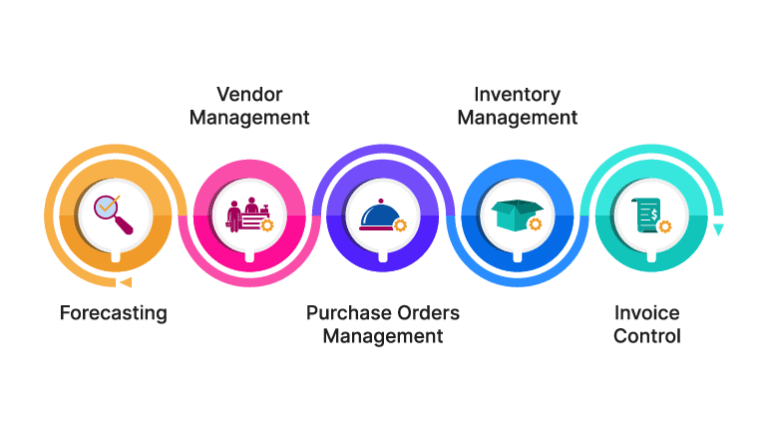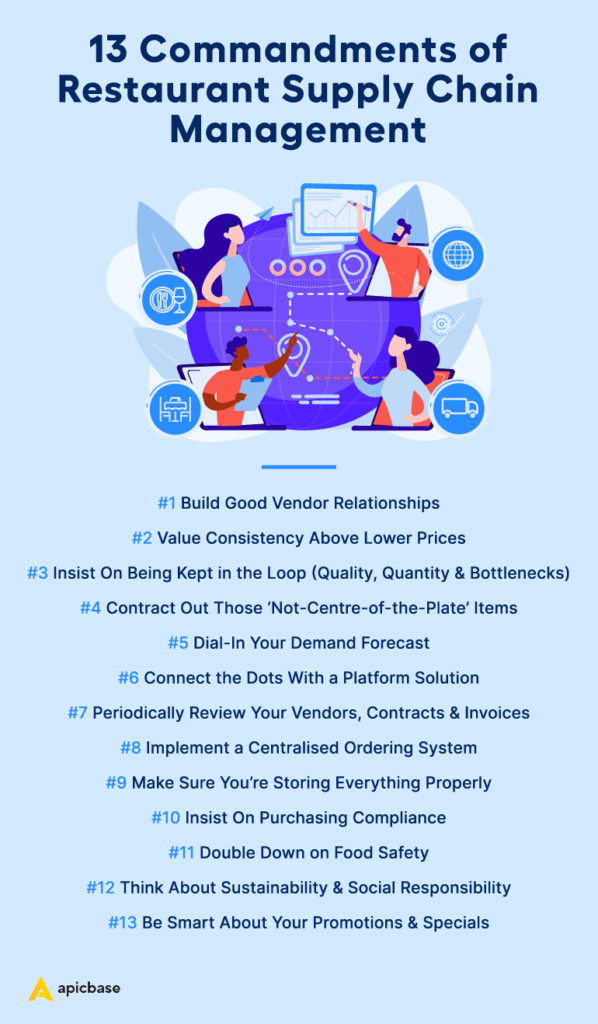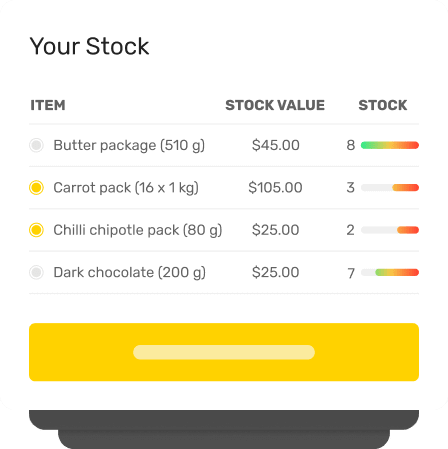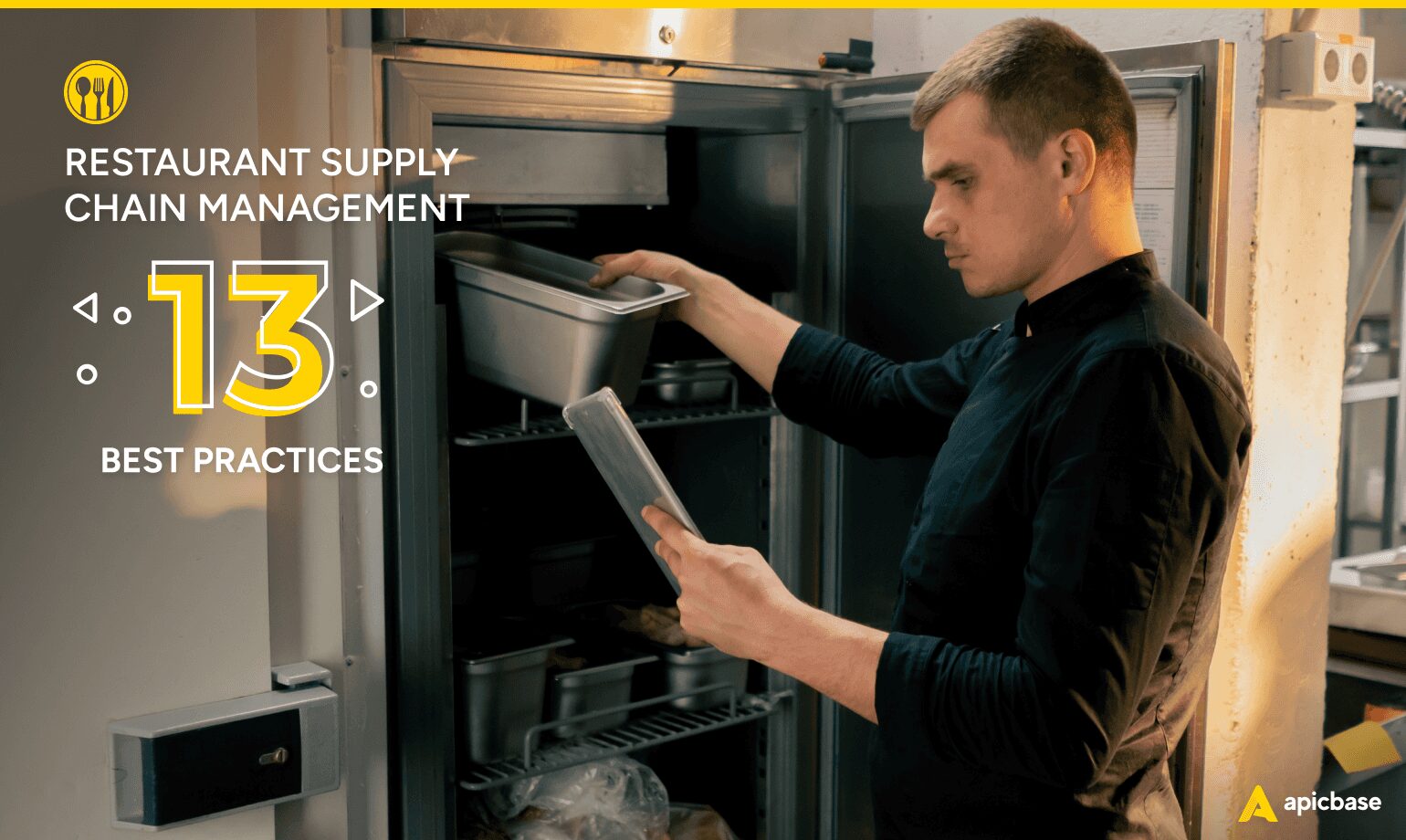Inefficiencies in a restaurant’s supply chain can increase costs, disrupt operations, and drive customers to competitors. Due to their scale, these issues are more severe for large restaurant chains and catering companies. Effective restaurant supply chain management is crucial to overcoming these challenges and ensuring a seamless operation.
In this post, we offer 13 best practices for managing your restaurant’s supply chain. These strategies will help you save money, bring clarity to operations, and boost resilience.
The goal is a supply chain where deliveries are always on time, costs are controlled, and operations run smoothly, even during unexpected challenges.

The list contains 13 solutions, each addressing a specific restaurant supply chain challenge. Implementing these will improve your system, resulting in:
- Increased value for your operation through higher purchasing power and lower food costs.
- Better synchronisation between supply and demand.
- Ensuring customer health remains a top priority.
Even if you can’t implement all the solutions, adopting a few will still benefit your bottom line. If you can manage to implement them all, more power to you.

Let’s optimise the restaurant supply chain management, starting with vendor relationships.
1. Build Good Vendor Relationships

The most common supply chain mistake restaurateurs make is ignoring vendor relationships.
No matter the size of the operation, there are always real people on the other end of emails and phone calls. People respond to honesty, transparency, and respect. Integrating these principles into every vendor interaction will secure better deals.
Additional strategies to achieve ‘favourite customer’ status include:
- Effective communication: Share important details with vendors, such as needs, timelines, schedules, and systems. Encourage vendors to do the same. This helps identify potential gaps and find solutions to bridge them.
- Timely payments: Vendors have their own bills to pay. Vendor representatives who go out of their way to accommodate customers will be less inclined to do so if they must constantly chase payments.
- Conflict resolution: Have open conversations with vendors about handling potential issues. Ignoring problems ensures they will recur.

Apicbase Takes the Guesswork Out of Restaurant Supply Chain Management
Connect all your outlets, eliminate data silos, and gain access to timely, accurate business-building insights.
2. Value Consistency Above Lower Prices
While a 20% lower price sounds fantastic, it doesn’t help your restaurant if deliveries are regularly late. If a truck arrives at your loading dock at 11 AM with essential items, your lunch hour is compromised.
When selecting a vendor, the top priority should be the quality of raw ingredients. The second priority should always be timely and consistent delivery. If a vendor cannot deliver on time, every time, it’s better to find another supplier.
Apicbase keeps track of performance in the vendor dashboards.
Recommended reading: The Complete Guide to F&B Procurement For Restaurants
3. Insist on Transparency

To maintain a tight grip on your restaurant’s supply chain, accurate and timely data is essential.
When deciding between vendors, choose the one willing and able to be upfront about their inventory and schedules. They should be able to inform you in advance about:
- Anticipated lower quantities that might not meet your demand.
- Potential quality issues that could result in substitutes.
- Internal issues, such as lack of drivers or truck malfunctions, that could impact deliveries.
If you can get this information a few days in advance, you can easily address any potential disruptions.
Recommended reading: 7 Restaurant Purchasing Mistakes That Affect Food Costs (& How to Avoid Them)
4. Outsource Secondary Menu Items
If you’re following the same strategy as most large operation managers, your focus is on “big money” items, i.e., high-cost and high-demand items like meats, dairy, and produce. This approach makes sense.
Big-money items significantly impact restaurant expenses and revenue. Small price fluctuations can lead to substantial changes in overall costs, making them a primary focus for managers aiming to control expenses and maximise profits.
However, do you give the same attention to the less prominent ingredients? Consider items like canned goods, condiments, broths or spices. These items might seem minor, but they deserve attention because optimising how you order these non-central items can result in significant savings.
For instance, changing your supplier for and mayonnaise saving €30 per month might not seem substantial. However, if you have 100 outlets, this amounts to €3,000 per month or €36,000 annually.
Apicbase Analytics and dashboards can help identify areas for improvement by showing which items you frequently use but might overlook. They provide detailed insights into your inventory usage, highlighting opportunities to optimise the ordering process, such as consolidating orders with a single vendor.
These insights help you make informed decisions, ultimately reducing costs and improving efficiency across all your outlets.
5. Data-driven Demand Forecasting

Efficient supply chain management for restaurants relies on data and planning. Indentifying demand patterns across all outlets and integrating this information into your supply chain strategy is crucial.
Here are three ways to leverage accurate demand forecasting to optimise your restaurant’s supply chain:
- Advance Planning and Negotiation: By mapping out quantities in advance, you can approach vendors early. This allows you to negotiate better terms by committing to larger purchases.
- Optimised Storage: Monitoring storage capacity and preparing for increased product intake at specific locations (e.g., by installing an additional cooler) helps minimise food waste.
- Accurate Delivery Planning: If you operate from a central production unit, precise order management, delivery scheduling and receiving are essential. This ensures each outlet gets what it needs on time. Maintaining a tight grip on these practices minimises waste, cuts costs, and ensures smooth operations across all locations.
You don’t need to be a math wizard to tap into these benefits. Modern tools, like Apicbase demand forecasting software, can help you analyse data and forecast demand effectively.
6. Connect the Dots: Recipe, Sales, Inventory, Procurement

Managing the supply chain of a large foodservice operation is challenging, but it becomes nearly impossible when using disparate and disconnected systems. Imagine having:
- Spreadsheets to monitor stock per unit
- Folders with purchase orders
- Different folder for invoices
- Email, phone or online ordering, depending on the vendor
This fragmented approach leads to inefficiency and confusion. It is a disjointed mix of legacy software, Excel sheets, handwritten notes, and emails. Managing such a system can be cumbersome, with numerous manual operations required to keep it running smoothly.
This often leads to reluctance among staff to engage in tasks such as filling in data accurately, copying information, checking details, and sending updates. Consequently, branches frequently get stuck and develop their own working methods. Some branches diligently perform stock counts and place orders, while others operate based on intuition, often opting for local suppliers.
As a result, opportunities to secure the best possible rates are missed due to the absence of bulk discounts, and orders are placed with suppliers without strong agreements in place.
These systems are impractical. Moreover, it is impossible to build dashboards on them or even create reliable baseline reporting. If the goal is to reduce food costs and waste, this is not the best way.
That’s why leading food service companies have switched to cloud-based platforms, like Apicbase. These systems bring together sales, recipes, inventory, and procurement across all outlets.
With everything in one place, operators and head office have the tools they need to manage the supply chain from start to finish. Sales history, stock levels, food costs, and supplier details—it’s readily available, eliminating the need to chase down information.
Take the Guesswork Out of Restaurant Supply Chain Management
Apicbase automates ordering, keeps an eye on inventory levels, and streamlines your supply chain management.
7. Periodically Review Vendors, Contracts & Invoices
Performance reviews can be tedious and time-consuming, often leading to extra work and potentially strained relationships. However, they are essential for separating the wheat from the chaff. Review the following every six months:
Vendor Evaluations
- Score your vendors on quality, price, and delivery, aiming for a perfect score of 10/10/10.
- Track every slip-up (e.g., late deliveries, price increases, incorrect quality) and adjust scores accordingly.
- Use these scores to identify underperforming vendors and consider replacing them.
Contract Evaluations
- Initial contracts may not offer the best deals compared to long-standing customers.
- As contracts come up for renewal, use your established relationship to negotiate better terms and prices.
Invoice Validation
- Conduct monthly invoice validations before payment.
- Ensure that the invoice matches delivered items in terms of quantity and quality.
- Verify that all discounts, rebates, approvals, and corrections have been applied.
If you conduct these reviews on a regular basis, you’ll be able to maintain high standards, secure better deals, and ensure accuracy across your outlets and kitchens.
Apicbase can assist you. The system’s vendor dashboards highlight suppliers that frequently underdeliver, display order amounts per vendor, track order flows and timely deliveries, and provide procurement details per unit. You can perform spot checks, monitor purchasing behaviour over time, and review vendor performance by simply opening your laptop.
8. Centralised Ordering System
One of the most significant supply chain management mistakes restaurant operators make is handling orders for each location separately. This approach presents several issues:
- Data Silos: Managing orders independently creates data silos, preventing a comprehensive view of the overall operation.
- Coding Errors: Mistakes in coding can lead to problems with applied discounts.
- Over-ordering: This method often results in over-ordering and increased food costs due to waste.
A centralised system ensures you are working with accurate data, which is crucial. Inaccurate data leads to unreliable systems, forcing you to make decisions based on guesswork and hope. It’s better to have a holistic view of procurement. This allows for better decision-making and improved supply chain efficiency.
Cut High Food Costs with Data-Driven Purchase Orders
When your kitchen teams use procurement software, every order they send to an F&B supplier is based on real-time data about stock levels, sales, and production needs. This helps you avoid overstocking and supply shortages, which can drive up your costs and eat into your margins.
9. Store Everything Properly
Create and standardise storage procedures across your operations to reduce waste and keep your customers healthy. Here are three key points to keep in mind:
Ample Storage Space
- Ensure each food category has ample storage space according to regulations (e.g., frozen goods in freezers, chilled products in coolers, root vegetables in cold, well-ventilated storerooms).
Immediate Storage
- Products should be put away immediately. Nothing should stay out for “just five minutes” because the receiving crew is overwhelmed. Remember, if it’s sitting on the dock, it’s going bad.
Maintained and Accessible Storage Spaces
- Storage areas should be regularly cleaned, maintained, and easy to access. Everything should be organised to allow for quick checks and counts. Follow FIFO (First In, First Out) principles to ensure proper rotation.
For large foodservice operations, make sure to train all team members regularly on product receiving and storage. Do spot checks now and then to spot any gaps and encourage staff not to cut corners.
10. Avoide One-off Purchases
Consider a small, family-owned diner that runs out of olive oil. Sending someone to the store might seem trivial. However, in a large foodservice operation with multiple outlets, this “run-out-to-the-store” approach can lead to significant problems. Off-contract purchases can be 5% to 40% more expensive.
More critically, this approach sacrifices traceability, control, and brand consistency. While buying local is appealing, it poses significant challenges for large-scale operations:
- Inability to obtain the necessary quantities of raw materials.
- Inconsistent product quality.
- Difficulty obtaining essential data, like allergen information or nutritional values.
That’s why it’s crucial to stick to large, contracted, and vetted vendors who can consistently meet your needs for quantity, quality, and information.
To reduce one-off purchases, follow these strategies:
- Build Strong Vendor Relationships: Cultivate relationships with dependable vendors who can consistently meet your quantity and quality requirements.
- Implement Robust Supply Chain Management: Use inventory management software that monitors inventory in real-time and automates reordering to ensure supplies are always on hand.
- Standardise Procurement Processes: Establish uniform procurement procedures across all outlets to maintain consistency and control.
- Train Staff: Ensure all staff understand and adhere to these procurement processes, emphasizing the importance of compliance.
- Document and Report: When one-off purchases are unavoidable, document them carefully and report them up the chain of command to maintain oversight and compliance.
Following these practices helps you control your supply chain. This ensures cost efficiency and smooth operations.
11. Double Down on Food Safety
At the heart of restaurant supply chain management is the crucial task of ensuring customer health and safety. This depends a lot on the systems you have in place. But remember, your system is only as good as the ones it connects to.
A common supply chain issue is focusing only on internal operations alone when the whole supply chain matters. To fix this, make sure all your partners, from farm-to-table producers to broad-line vendors, have a Quality Management System (QMS) in place.
A solid QMS should include:
- Food Quality Audits: Regular checks to ensure products meet standards.
- Onboarding New Products: Rigorous checks to maintain quality and safety.
- Quality Assessments: Continuous evaluations to keep standards high.
- Guidelines for Product Recalls: Clear procedures for handling recalls efficiently.
Document and review your QMS regularly to spot and fix any gaps. Regulatory inspections will look at these systems more often than you might think, so staying on top of things is crucial. By making sure every link in your supply chain follows these standards, you can keep your operations strong and reliable, protecting your customers and your reputation.
12. Sustainability & Social Responsibility
There are two things important in this context.
One, consumers are increasingly willing to pay a premium for all-natural, organic, sustainable or environmentally friendly food, according to a study by Euromonitor.
Two, in the context of sustainability, the Corporate Sustainability Reporting Directive (CSRD) plays a crucial role. This directive mandates that large companies disclose information on how they operate and manage social and environmental challenges.
Industries worldwide are slowly but surely transitioning to sustainable processes, services, and products. The Corporate Sustainability Reporting Directive (CSRD) is one way the EU is driving this transition.
While compliance may initially add complexity, it offers several key benefits:
- Level Playing Field: Since CSRD is a universal directive, all competitors must also comply. This ensures a level playing field where everyone is held to the same standards.
- Enhanced Transparency: By openly sharing your sustainability practices, you build trust with stakeholders, including customers, investors, and regulators.
- Increased Credibility: Demonstrating a commitment to sustainability can boost your reputation and establish your brand as a leader in responsible business practices.
- Improved Decision-Making: Regular tracking and reporting of sustainability practices help identify inefficiencies and drive better decisions.
- Operational Efficiency: Compliance encourages digitalisation and process assessment, often uncovering inefficiencies that make operations more error-proof and profitable.
To comply with CSRD, restaurant operators must diligently track and report their sustainability practices. The reports compel operators to assess their processes and practices, a task often postponed.
While this can be a laborious exercise, it frequently uncovers inefficiencies. When these are addressed, it makes the job easier for staff, reduces food waste, boosts profits, and generally makes operations more error-proof. Additionally, companies that digitalise more extensively tend to amplify these benefits.
Key areas to focus on include:
- Resource Management: Efficient use of water, energy, and raw materials.
- Waste Reduction: Implementing practices to minimise food waste and promote recycling.
- Supply Chain Sustainability: Partnering with suppliers who share your commitment to environmental and social responsibility.
Still, it’s challenging to discuss sustainability and green responsibility within the restaurant industry and its supply chain, especially for large operations. You need large quantities, product traceability, and extensive producer-supplied information. Buying local, which can reduce your supply chain’s carbon footprint, is rarely an option.
However, there are several steps you can take to get on the green track:
- Incorporate Plant-Based Alternatives: This strategy can make a big difference. Plant-based foods generally have a lower carbon footprint compared to animal-based products. By promoting plant-based proteins on your menu, you can significantly cut your environmental impact. Plus, these alternatives are becoming more popular and can attract a growing number of eco-conscious customers.
- Connect with Local Green Food Supply Chains: Local green food supply chains are gaining traction as small producers collaborate to expand their offerings and appeal to larger operations. While it may not be possible to source all your ingredients this way, it is certainly worth exploring for locations near these networks.
- Partner with Large Local Producers: Collaborating with large local producers can bring substantial benefits to your restaurant operations. For instance, if you have several outlets in Scotland, partnering with a local beef producer can significantly shorten your supply chain compared to sourcing from Argentina. This approach often makes more financial sense.
- Cook with Seasonal Ingredients: If possible, tweak your menus a few times a year to highlight in-season ingredients. This reduces shipping pollution and can help lower costs.
Taking these steps can help you make meaningful strides towards sustainability without sacrificing profitability.
13. Think Twice About Promotions & Specials
Specials and promotions can put significant pressure on your inventory. While setting a time limit on these offers can help, running out of a key ingredient early can negatively impact customer satisfaction and lead to bad reviews. To ensure you meet customer demand even if it exceeds your forecast, follow these steps:
- Check Product Levels with Your Prime Vendor: Reserve additional quantities in advance if possible to avoid shortages.
- Communicate with Other Vendors: Assess their available quantities and quality to prepare for any potential shortfalls.
- Control Specials and Promotions: Schedule promotions on specific days or implement strategies to manage demand more effectively.
Planning ahead and maintaining open communication with your suppliers helps to avoid inventory shortfalls and ensures a seamless customer experience during promotions. This proactive approach helps maintain customer satisfaction and protects your reputation.
Improve Restaurant Supply Chain Management With Apicbase

Apicbase makes ordering for 100+ outlets feel like ordering for a single outlet by centralising and automating core functions, leveraging par-level reminders and assistive ordering.
How Apicbase Helps:
- Centralised Operations: Apicbase integrates inventory, procurement, recipes, and compliance across multiple locations in a single platform. This ensures consistency, improves communication between locations, and streamlines processes, leading to more efficient and cohesive management of the entire supply chain.
- Real-time inventory tracking: The platform offers real-time inventory tracking, helping food service all locations maintain optimal stock levels, reduce waste, and prevent shortages. The system automatically updates theoretical inventory through the POS integration.
- Par Level Reminders: Apicbase tracks your inventory levels and notifies you when supplies fall below predetermined thresholds. This ensures you reorder stock before it runs out, maintaining smooth operations.
- Demand Forecasting: Advanced demand forecasting tools analyse historical sales data, current stock levels, and other variables to predict future purchasing needs. Apicbase creates purchase orders for each supplier, aggregating them in the most cost-effective way.
- Assistive Ordering: The system uses real-time data to suggest optimal order quantities based on your current inventory and production needs. This reduces the risk of overordering or underordering.
- Compliance and Traceability: Apicbase boosts food safety and compliance through forward and backward traceability of ingredients from supplier to plate. Recipes and menus contain allergen information, nutritional values, and carbon footprints. Through the Apicbase API, this information can be dynamically pushed to customer-facing tools, kiosks, and other apps.
- Data Analytics and Reporting: Comprehensive dashboards, analytics, and reporting features give you actionable insights into your supply chain. Operators can track key metrics such as inventory turnover, cost of goods sold (COGS), and supplier performance.
By centralising all processes, Apicbase gives you back control, streamlining operations and making restaurant supply chain management more efficient.

See Apicbase in Action
Apicbase is explicitly designed to manage the complex operations of multi-site and enterprise-level food service companies, including central kitchens.

